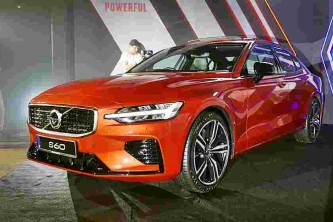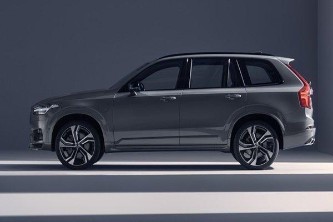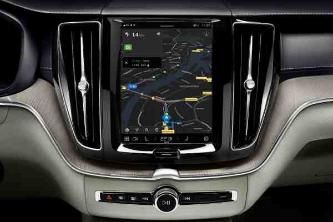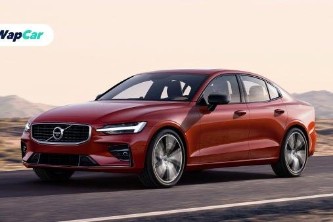carburetor volvo 240
บทความที่เกี่ยวข้อง carburetor volvo 240

2020 BMW 330e vs 2020 Volvo S60 T8 - Which is the better plug-in hybrid?
- Volvo S60 T8 takes the cake Performance Comparison BMW 330e Volvo S60 T8 Engine
Volvo Car Malaysia launches its official used car programme called Volvo SELEKT
Volvo Car Malaysia today paved a new path for customers with the launch of its 360 total-care used car
We need to talk about Volvo, but not about its safety
Is Volvo a true rival to Mercedes-Benz and BMW? Can Volvo take the spot currently occupied by Audi?
Next-gen Toyota 86/Subaru BRZ to get N/A 2.4L engine with 220 PS/240 Nm
Subaru BRZ will use a larger, 2.4-litre naturally aspirated flat-four engine that makes 220 PS and 240
2020 Volvo S60 T8 PHEV CKD, what’s new and everything you need to know
Volvo Car Malaysia (VCM) has officially launched the locally-assembled (CKD) 2020 Volvo S60 T8 PHEV R-Design
Volvo S60 T8 vs Mercedes-Benz C300 vs BMW 330i, which is best for you?
The locally assembled (CKD) Volvo S60 T8 has arrived and now it is at level playing field with the Mercedes-Benz
2020 Volvo S60 T8 R-Design, best value-for-money compact exec?
But really, if you put all of them side by side, the Volvo S60 T8 will triumph.Really?
New 2021 Volvo S90 spotted in Malaysia ahead of local launch
Volvo Car Malaysia will be launching the new 2021 Volvo S90 facelift, now wearing the new ‘Recharge
BMW X5 PHEV vs Volvo XC90 T8 - Which is the better buy?
Meanwhile, the Volvo XC90 T8 Inscription Plus goes for RM 391,150 (without SST).Volvo XC90We’ve
Volvo Car Malaysia opens new 3S centre in Kota Kinabalu, Sabah
There’s a new Volvo 3S centre in Malaysia and this time it is located in Kota Kinabalu, Sabah.
Volvo ramps up electrification with 2021 Volvo C40 Recharge
Volvo is intent on walking the talk when it comes to phasing out internal combustion engines (ICE).
Volvo announces biggest global recall - 2 million cars affected
Volvo Cars have just announced its biggest global recall ever.
Dispose your e-waste properly at your nearest Volvo Car showroom!
Volvo Car Malaysia has partnered with E-waste Recycling Through Heroes (ERTH) to provide E-waste Green
Volvo Car Malaysia adds one more 3S centre in Johor
’s Volvo Car 3S Centre in Skudai is now open for business.Located in the outskirts of Johor Bahru
Review: Volvo S60 T8 R-Design – Much better than a Mercedes?
It would be a stretch to call the Volvo S60 T8 astonishing, but having tried it, I must say, it&rsquo
In Thailand, new Volvo cars are protected from the sun
Volvo Cars Thailand (VCT) has taken quality control to the next level with the opening of a new warehouse
Ratings: 2020 Volvo S60 T8 R-Design - The best sports sedan in class
Having tested the Volvo S60 T8 R-Design last year, we have to say, we were quite impressed.
Volvo XC60 T5 vs T8 – Should you consider a hybrid?
There are 3 variants available for the Volvo XC60 – T5, T8 Inscription, and T8 Inscription Plus
Volvo gives the XC40 a zap of Recharge
To recharge or not to recharge, that is the question that all Volvo XC40 buyers will have to answer when
Volvo Car Malaysia extends its factory warranty for free
Volvo Car Malaysia has revised its warranty programme to a factory five-years/unlimited mileage for all
รีวิวโพสต์ carburetor volvo 240
@Aliyujari Growing up, you could not take tge car out until you knew how to change a tyre, clean plugs, bleed a carburetor and tune a contact set. It was a Datsun 180B. After this you could touch the Volvo 240.
รีวิว Q&A carburetor volvo 240
Why do most cars have an even number of cylinders?
Being 4 stroke engines each cylinder takes 720 degrees to complete a cycle. A 2 cylinder engine has both pistons rising and falling together to keep the firing intervals spaced evenly at 360 degrees. As as one cylinder is firing on the down stroke its neighbor is going down on its induction stroke and has to come all the way back up till it fires 360 degrees. Good for a smooth power delivery but balance wise similar to a single cylinder. If you have a twin with the crank shaft offset 180 degrees you have good balance but a unbalanced power delivery of 180 degrees and 540 If you go to inline 4 cylinders you have 2 pairs spaced 180 degrees with a power stroke every 180 degrees with no over lap of the power strokes An inline 6 cylinder has 3 pairs spaced at 120 degrees with firing intervals of 120 degrees an a 60 degree over lap of the power strokes, a v 6 gets messy because of angle of the v and the firing angles A 3 inline cylinder is half of the in line 6 with a 120 degree crank and 240 degree firing angle and a 60 degree gap in the firing angle A 90 degree v 8 gives you the 90 degree offset by running 2 con rods on the same bearing journal firing intervals of 90 degrees an a 45 degree over lap of the power strokes Before fuel injection 5 cylinder engines were impossible to get even fuel distribution from a single carburetor, A 3 cylinder had the same problem but not as bad. A 4 cylinder could have twin carburetors and a 6 can use 3 carburetors , 5 carburetors on a 5 cylinder would be enough to put most manufactures off even the 6 cylinder carburetor fitted motorbikes had 3 carburetors to keep costs down and save some space A 3 cylinder is good for a small car but a 5 cylinder! more to make than a i4 and not as smooth as a i6 you can just fit the i5 into a front wheel drive but it will be tighter fit than a v6 that is shorter than a i 4 The Future Dims for the Five-Cylinder Engine The three-cylinder? Now that's a keeper. Fans of oddball engines were dealt a blow recently when Volkswagen and Volvo both announced that they intend to phase out their five-cylinder powerplants. Among the last of their kind in the U.S., both ,will be replaced by turbocharged fours with fewer liters,. Chalk up the rush to fewer cylinders and smaller displacements to the pursuit of higher efficiency and lower cost. Why lament the five? Its key attribute is a torque pulse every 144 degrees of crank rotation versus 180 degrees in a four-cylinder. And while never as common as engines with even cylinder counts, fives have been a part of the automotive scene longer than many realize. Henry Ford studied inline-fives in the 1930s and continued to investigate the quint—including overhead-cam versions with aluminum block and head construction—until he died in 1947. Five-cylinders do not suffer from the shaking forces that keep four-cylinder noise-and-vibration engineers employed. Their main faults are primary and secondary rocking couples that cause the engine to oscillate in the vertical plane. An engineer on one early Ford project noted: "When that engine was running at high speed, it was going back and forth every which way. You got scared to look at it." But simple counterweights attached to each end of the crankshaft correct the primary couple; the secondary-imbalance flaw is generally minimized by careful tuning of the engine and transmission mounts. The benefit of all this bother is that fives fit where shorter but wider V-6s and longer inline-sixes can't. In 1974, Mercedes-Benz installed a five in the 300D. We called it the world's fastest diesel—and the world's slowest $12,000 car. This naturally aspirated 3.0-liter produced 77 horsepower, resulting in an agonizing 17.3-second crawl to 60 mph. In 1977, Audi introduced the ,5000 sedan, and upgraded the Fox's 81-hp, 1.6-liter four to a 103-hp, 2.1-liter five by adding a cylinder and lengthening the stroke. Vibration levels were reasonable, and we found the engine to be superior to a four-cylinder of the same displacement. In 1980, Audi added two five-cylinders: a 130-hp turbo and a 67-hp diesel. Audi's success opened the floodgates. During the past three decades, Acura, GM, Land Rover, and others have built and sold millions of fives around the globe. All is not lost yet, however. VW has given no time frame for the departure of its five—and Audi hasn't said anything about the fate of the ,TT RS,'s turbo quint—but Volvo's could stick around as late as the end of the decade. And, as the industry continues to downsize, it's possible that some companies coming down from six, eight, and even ten cylinders will again adopt the format. three cylinders rising The curtain may be dropping on the five, but it's prime time for another prime-cylindered engine: the three. In almost the same breath as he announced that his company was getting out of the five-cylinder business, Volvo R&D boss Peter Martens revealed the Volvo Environmental Architecture, which will encompass new 2.0-liter four-cylinder and 1.5-liter three-cylinder direct-injection gas and turbo-diesel engines. The goal is to shave up to 200 pounds while boosting fuel efficiency by 35 percent. Threes are new to Volvo, but other brands—Fiat, GM, Honda, Mitsubishi, Smart, Subaru, Suzuki, and VW among them—already sell them in markets where minimizing costs is crucial. Ford recently added a 1.0-liter three-cylinder to its portfolio , and ,BMW is developing one, too,. Fiat even launched a 0.9-liter two-cylinder in the European-market 500, to serious—and surprising—critical acclaim. With 240 degrees of crank rotation between power pulses, threes tend to be uncouth. Like fives, they suffer from primary and secondary rocking couples. And, as in fives, these forces are calmed in threes with counter-weights and mount tuning. Computer-aided design has helped minimize reciprocating masses, easing the task. And, thanks to direct injection and turbocharging, power is usually not an issue. ,Ford has said it will offer the 1.0-liter engine here (in the Fiesta and possibly even the Focus,); other brands are sure to follow suit.
With desirable premium automobiles being so expensive ($60kUSD++) does it make more sense to buy a fully restored classic for similar money?
Maybe. Define “fully restored.” Define “classic.” Defines “makes more sense.” I think the sweet spot here is something European from the late 1980s or early 1990s, or Japanese from the 1990s. Something with electronic fuel injection, airbags, and ABS. Is that a “classic”? If your definition of “classic” is older, like a 1968 Mustang fastback or a Porsche 356, then you’re probably better off with a new car. For the most part, cars - even good ones - were vastly less reliable and considerably more maintenance-intensive before the 1990s. German cars got relatively low-maintenance in the mid-80s, when they stopped requiring valve clearance adjustments and carburetor adjustments. Safety is also an important consideration here. Even if you consider cars that were benchmarks for safety in their time, like the Volvo 240 and W126 Mercedes S-Class, they are not ,nearly, as safe as the lowliest econobox on sale today. And when you look at “makes sense,” amenities may matter to you. I have a friend who traded in a perfectly good 2-year-old car for a new version of the same model, just so he could get the new keyless starting feature. If you’re into the latest and greatest infotainment screens in the dash, then even a mechanically perfect classic car isn’t going to feel luxurious to you. And finally, the level of restoration matters. My daily driver is an ’86 Porsche 928, and there is just no way to do a true, full, rotisserie restoration on one for $60k. But you can buy one that is in good shape, under 100k miles, with service records, for $25–35k. If you replace all the “mission critical” rubber pieces like fuel lines, fuel injectors, and cooling system hoses, you’ll have a very reliable car. It will cost more, on top of that, to make the exterior trim and interior look new. It’s unlikely to depreciate, but you’re also taking on a significant maintenance expense. My expense records say that you can drive one of these for vastly less per month than you would pay for a new Porsche, so yes, I think there are situations where this can work. Thanks for the A2A.
What is your favorite 4-cylinder engine?
I’ve owned 4 60’s 70’s VW’s, a 912 Porsche and a 240 Volvo. The Volvo engine was bulletproof but not in the least peppy. The VW Beatles were good for 40k then they needed rebuilding. The 912 looks like a 911 but it had a 4 cylinder vs a 911’s 6. It was really peppy for a tuned 4. 2, 2bbl carburetors, larger displacement I think 1600 cc, a hot cam and tuned exhaust. VW was no match for the 912 but everything else on the street would blow it away. It would do 6500rpm and made a great growling sound. The handling was superb. I also owned a 1966 Land Rover 109. It was purchased new by my father in law and was worn out when we adopted it. I spent two years totally restoring it to like new . It had a 4 cylinder engine with 77 hp and a 7:1 compression ratio. The same block was used for the diesel version. It was truly a good, reliable engine that held 7qts of all. The rest of the 109 was pure English junk in design and hp. It got maybe 10 mpg! Junk. I sold it for $13,500 in the late 80’s and I’ve never been so glad to use the word “gone”! Today I’m 72 and still crazy. I just bought my 2nd hot rod. One was a INFINITI V6 on which I put a supercharger. It made 435hp. Now I have a 556hp Cadillac CTS-V which is a rocket. It takes 8 cylinders to make CRAZY!
 หน้าหลัก
หน้าหลัก 


